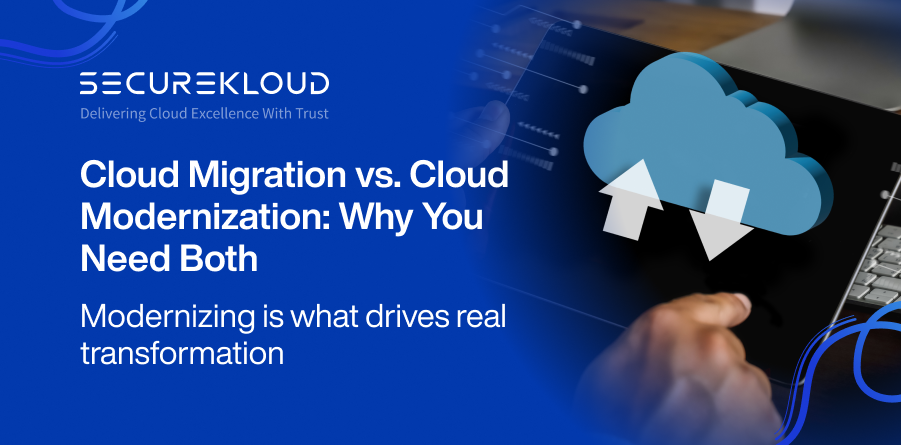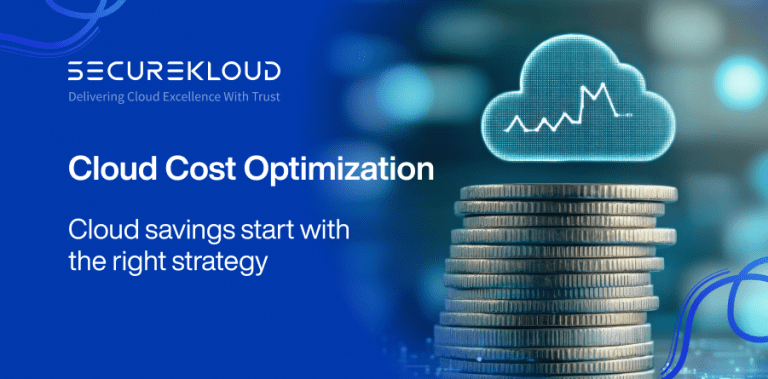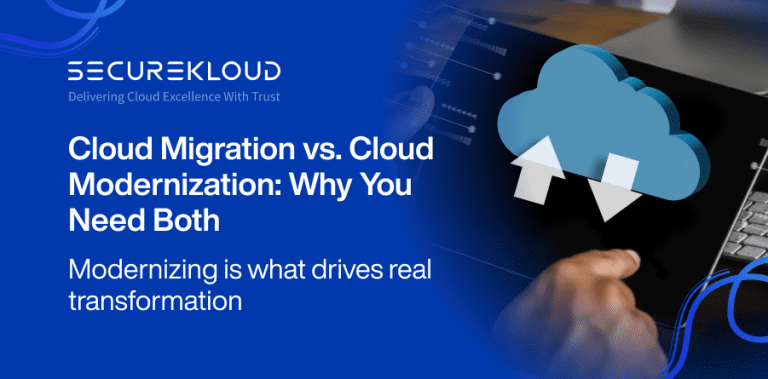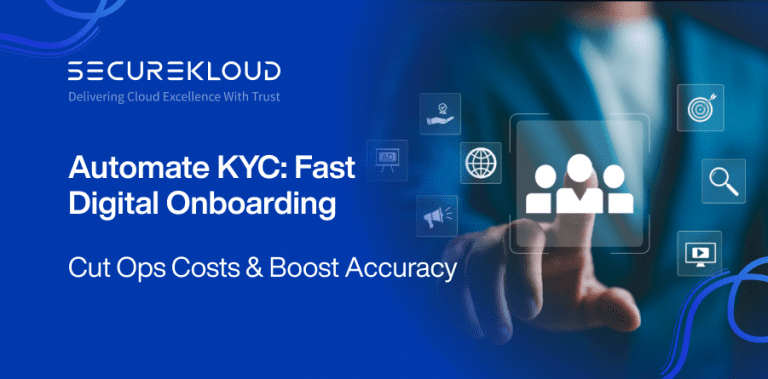- 5Minutes
- 1055Words
- 13Views
Moving Applications to the Cloud Is Only Step One
Cloud migration is a milestone, not the destination. Cloud adoption has become a business essential. However, migration alone cannot deliver agility and innovation unless it’s followed by strategic modernization. That’s where transformation often falls short.
Cloud migration is only the foundation of IT infrastructure modernization. It helps move workloads from legacy systems to the cloud. But real innovation begins with application modernization. It is about turning those workloads into cloud-native, intelligent, and resilient systems.
At SecureKloud, we help enterprises bridge this gap. Our cloud application modernization services upgrade legacy systems for better performance, compliance, and agility, unlocking the full power of your cloud investments.
Cloud Migration — The First Step in Modernization
Cloud migration means moving applications to the cloud environment (AWS or Google Cloud). The main goals are to cut hardware costs, boost performance improving business continuity. By taking this first step, enterprises build a resilient base that supports cloud security, agility, and continuous improvement.
The 6 R’s of Cloud Migration Strategy
- Rehost (Lift & Shift): Move applications as they are for a quick transition.
- Replatforming: Make small improvements to use cloud-managed services.
- Repurchase: Switch to a SaaS product built for the cloud.
- Refactor/Rearchitect: Rebuild apps for full cloud-native performance.
- Retire: Remove applications that are no longer needed.
- Retain: Keep specific workloads on-premises as part of a hybrid model.
Why Cloud Migration Alone Is Not Enough
Migration gives your business a digital foundation, but it doesn’t guarantee transformation. Many companies adopt the cloud but still depend on outdated architectures that hinder agility.
Whether your strategy is simple or multi-cloud, we offer cloud migration and managed services. We ensure a smooth, compliant, and optimized move.
Understanding Application Modernization Services
If migration is about moving, then modernization is about improving. The focus is on updating old systems and software into modern, cloud-ready frameworks that perform faster and scale better. Outcome is to improve performance, reduce technical debt, & create flexibility for future innovation. Modernizing your applications helps IT evolve from a maintenance function to a strategic growth enabler.
Core Pillars of Enterprise Application Modernization
- Code Refactoring: Redesign older applications to be faster, more flexible, and ready for the cloud.
- Containerization: Use tools like Docker and Kubernetes for scalable, consistent deployment.
- Data Modernization: Upgrade databases using cloud data migration best practices.
- DevOps Integration: Automate and speed up development with CI/CD pipelines.
We deliver full-stack application modernization solutions. We modernize systems end-to-end, reducing cost and increasing reliability.
Key Difference
| Cloud Migration | Application Modernization |
|---|---|
| Move workloads to the cloud | Redesign apps for better performance and business value |
| Focus on infrastructure (servers, databases, storage) | Focus on application code, APIs, and architecture |
| Lower upfront cost | Higher upfront investment but long-term ROI |
| Quick efficiency and reduced infrastructure cost | Greater agility, faster updates, and long-term optimization |
| Rehost, Retain, Replatform | Refactor, Rearchitect, Repurchase |
Our Full-Stack Application Modernization Solutions
We enable complete transformation through a unified approach combining cloud migration & application modernization. We specialize in both strategic cloud migration and end-to-end modernization.
Wrap Up
Don’t just move your applications. Modernize them.
Partner with SecureKloud to transform your cloud strategy into a true business advantage.
Cloud migration means moving existing applications and data from on-premises systems to a cloud platform like AWS or Google Cloud.
Cloud modernization goes a step further — it redesigns or refactors those applications to be cloud-native, faster, and more scalable.
Modernization helps enterprises unlock the full ROI of cloud migration. Without modernization, businesses only relocate legacy issues to the cloud.
By modernizing, you reduce technical debt, increase agility, and enable faster innovation through automation, DevOps, and containerization.
The 6 R’s define cloud migration paths:
- Rehost (Lift & Shift) – Move applications with minimal changes.
- Replatform – Make slight optimizations for cloud use.
- Repurchase – Switch to a cloud-based SaaS product.
- Refactor/Rearchitect – Redesign for full cloud-native performance.
- Retire – Decommission unused apps.
- Retain – Keep select workloads on-premises.
Modernization improves performance by refactoring legacy code, containerizing workloads, and using DevOps automation for continuous integration and deployment.
This helps enterprises achieve scalability, lower downtime, and better resource efficiency compared to legacy systems.
Combining both ensures faster time-to-market, lower infrastructure costs, and continuous innovation.
Migration builds the foundation; modernization delivers agility and resilience. Together, they create a future-ready IT ecosystem that drives business growth.
If your goal is cost reduction and quick cloud adoption, start with migration. If you want long-term scalability, automation, and digital transformation, go for modernization — or ideally, plan both in phases.
SecureKloud helps design hybrid roadmaps that fit your cloud maturity stage.
Common challenges include legacy code complexity, data migration issues, and security compliance.
Partnering with experts like SecureKloud helps enterprises overcome these by using structured frameworks and automated DevOps pipelines.
In India, sectors like BFSI, Manufacturing, Healthcare, and NBFC’s gain massive value from modernization.
They experience reduced downtime, improved compliance, and faster innovation across digital workflows.
Depending on system complexity, cloud modernization can take 8–24 weeks.
SecureKloud’s phased approach — assess → migrate → modernize → optimize — ensures faster ROI and minimal disruption.





